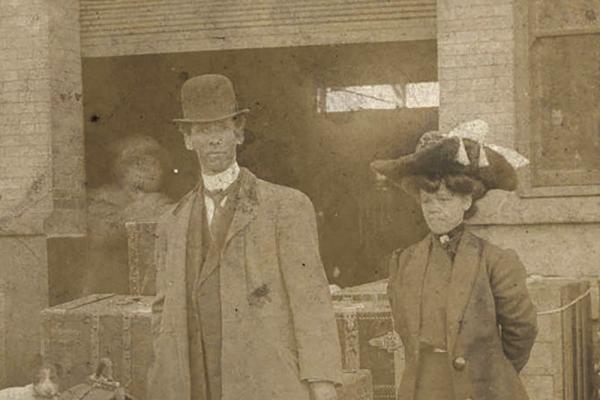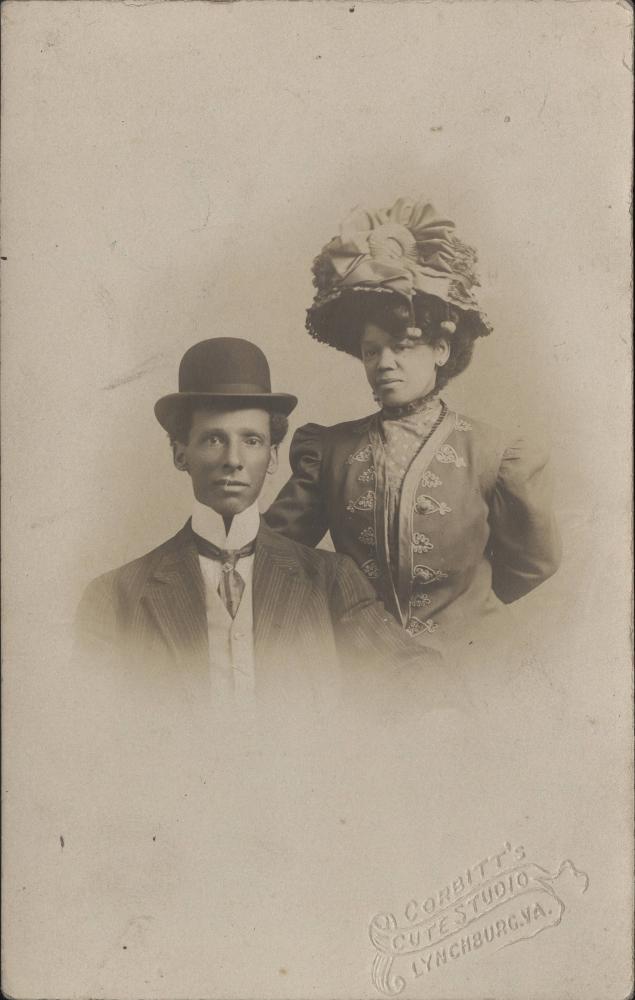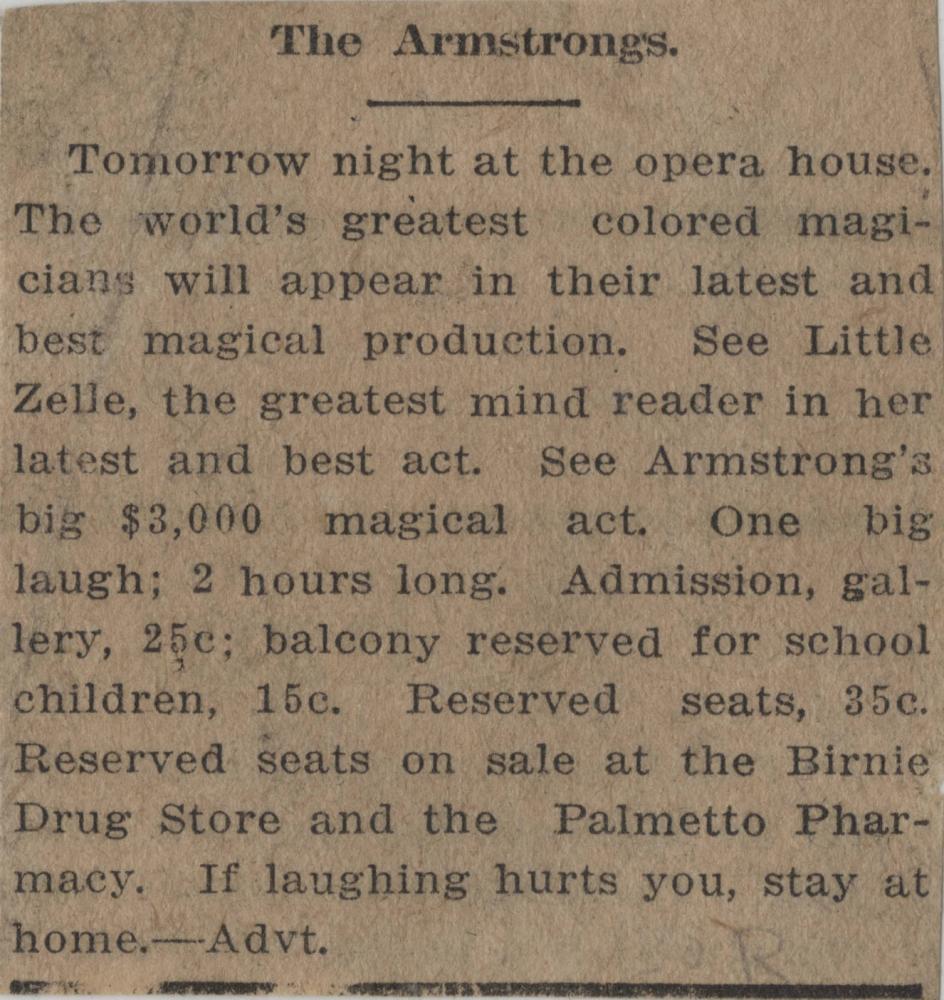Our Search for the Celebrated Armstrongs

J. Hartford and Lille Belle Armstrong on a train platform with a dog and luggage.

J. Hartford and Lille Belle Armstrong on a train platform with a dog and luggage.
“Going fine since 1889,” was the famous slogan of a family that dazzled audiences throughout the East Coast and perhaps even graced the stages of Europe.
The Celebrated Armstrongs, a family of African American illusionists and entertainers, performed before Black and mixed-race audiences in churches, opera houses, schools, and theaters along the Atlantic Seaboard for over half a century. Mixing humor with conjuring and mentalist tricks, the Armstrong family achieved success in defiance of Jim Crow oppression. Some of the illusions they performed—the Miser's Dream, Puzzling Parasol, and Sand Frame—are still popular with audiences today. Many details of their act, however, have been obscured or lost over time.
The South Caroliniana Library, a special collections library at the University of South Carolina, holds more than 100 items documenting the Armstrong family’s work and legacy, including photographs, promotional posters, and news clippings. Images from the library’s digital collection of Armstrong Family Papers have been featured on the American Black Story, Facebook, Flickr, Pinterest, and the Charleston Post and Courier newspaper.
We were fascinated by the collection, but we were also aware of its limitations. The news clippings were undated, their sources rarely identified. Questions arose. How did the Armstrongs’ act evolve? Is it possible to reconstruct their tour itinerary? We wondered if we could fill in the gaps in our knowledge by searching Chronicling America, the largest freely accessible aggregation of U.S. historical newspapers.
We knew the basic facts about the Armstrong family and their act. John Hartford Armstrong (1886(?)–1939), a native of Spartanburg County, South Carolina, founded the troupe, performing alongside his half-brother Thomas L. Armstrong (1877–1934) before adding his wife Lille Belle Armstrong (1881–1947) and daughter Ellen Armstrong (1905–1994) into the act. John Hartford specialized in conjuring tricks: changing an egg to a chick; making coins appear and disappear; and even magically pulling sausages from an audience member who purportedly worked as a butcher. Lille Belle, described in an unattributed news clipping as “the wonder of the age, who shares equal honor in her most mysterious and puzzling act,” performed mentalist tricks. Ellen started performing at the age of six. Chalk Talk was a staple of her early repertoire, a routine that involved drawing characters on a chalkboard. Ellen and Lille continued the act after John Hartford’s death in 1939. In 1949, Ellen Armstrong’s collection of stage props was valued at $8,500 ($106,897 in today’s currency).
With this information, we turned to Chronicling America to learn more. We confirmed the family performed in major Southern cities including Nashville, Tennessee, Raleigh, North Carolina, and Richmond, Virginia. We found references to other Black illusionists such as Alonzo Moore and Black Carl, who were performing around the United States at the same time. We did not, however, find any news clippings that exactly matched those in the scrapbooks digitized by the South Caroliniana Library, so our search will continue as more African American newspapers become available on Chronicling America.
Of course, even with a more complete historical record to search, research obstacles abound. The lack of consistency in identifying the troupe proved especially frustrating. Newspapers variously identified John Hartford Armstrong as Prof. J. Hartford, Prof J. Hartford Armstrong, and even Hartford the Great. They identified the troupe as the Armstrong Brothers, Armstrong Bros., Celebrated Armstrongs, or simply the Armstrongs. We found ourselves having to search by outdated terms like “colored magician” to yield the most relevant results. The Chronicling America research aid, Race and Ethnicity Keyword Thesaurus, can be especially helpful for finding terms that were used in a given period.
Overall, however, the challenge of finding additional information on the Armstrong family has impressed us just how few turn-of-the-century Black newspapers are preserved and available online. In previous grant cycles, the South Carolina Digital Newspaper Program contributed the few extant issues of the Charleston Afro-American Citizen, Columbia People’s Recorder, Georgetown Planet, and Rock Hill Messenger, among others, but we would like to increase our representation of Black Carolinian voices. Our timing is fortuitous, as recent changes in the NEH’s Notice of Funding Opportunities for the National Digital Newspaper Program now enable us to consider more options of titles to select.
The Celebrated Armstrongs, along with other turn-of-the-century Black illusionists, are experiencing a renaissance of interest. Hanif Abdurraqib’s Notes in Praise of Black Performance: A Little Devil in America has reaffirmed the troupe’s legacy, and the podcasts Stuff Mom Never Told You and Womanica have devoted episodes to Ellen Armstrong. A feature-length documentary, supported by the South Carolina Humanities Council and titled Going Fine Since 1889: The Magical Armstrongs, is also in the works. It promises to feature privately held family scrapbooks and stage props, as well as include recreations of illusions the family performed.
As our own experience demonstrates, freely available digitized newspapers are essential to uncovering the facts and stories to understand this history. We look forward to seeing the finished results and to helping facilitate further discoveries through our participation in the National Digital Newspaper Program.
Craig Keeney is the Cataloging Librarian for the South Caroliniana Library at the University of South Carolina and serves as the co-principal investigator for the South Carolina Digital Newspaper Program’s NDNP 2022-2024 cycle. Laura Carter serves as project manager for the South Carolina Digital Newspaper Program within Digital Collections at the University of South Carolina.





